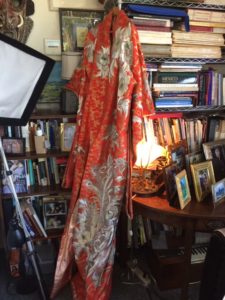 Just in the last 4 months, I received many emails asking for values of Japanese Kimonos, emails from all over the world.
Just in the last 4 months, I received many emails asking for values of Japanese Kimonos, emails from all over the world.
- A great-uncle brought a black kimono back after WWII
- We found an old kimono in slightly bad shape in the attic (marked 1860)
- I own a kimono worn as fashion. should I wear it out? Is it expensive?
Today I received from JF a photo of a mid-20th century ceremonial wedding kimono. When something reaches critical mass, I listen, let the market speak for itself. Kimonos that once possessed no market are now sought after. JF’s sent me a photo of a traditionally red wedding kimono, from the mid-20th century, worth on today’s market at least $1,000. This represents a huge increase in value; read on for the reasons.
Asian apparel from the 19th century or earlier, is always collectible. Such auction houses as I M Chait in Beverly Hills have done well – up to the $6K range- over the years. Of especial interest are the Chinese Court jackets, intricately embroidered, fitted, with bell sleeves. Unlike kimonos these are collected for historical and artistic value. The antique handmade and hand painted Japanese kimonos of about 100 years ago can be equally valuable, but kimonos are difficult to appraise because they are ‘classic’, meaning that the shape and ceremonial nature of the kimonos, colors, and designs, have not changed for 800 years.
As far back as 1,200 years ago, Japanese tailors discovered that cutting kimonos in straight line cuts maximizes the beauty of the silks, as well as fit almost every body type. Not only that, but they were easy to store folded into a few sections. Both men and women wore these gorgeous robes, and having fine color sensitivity, clothing artisans composed various color combinations to celebrate the seasons and the represent the wearer’s class.
The art form was formalized and some say perfected in the Edo period (1603-1858), an era dominated by the Tokugawa Warrior Clan. Clansmen were identified by their Kimonos. Warriors passed down their precious kimonos through the period. History books described the battlefields of the era as colorful as a field of bright flowers. These warriors layered their kimonos: a special undergarment emphasized the shoulders.
The Meiji period (1868-1912) in Japan saw a change in government sympathetic to European traditions, and government and military personnel were required to wear Western clothing. Ordinary citizens wore a kimono for a ceremony. A required family crests (I see a lot of those) to identified a wearer’s family. Unless kimonos from this era are full length and colorful, and silk, of course, the value is limited to historical value.
A few months ago, I wrote about Kabuki masks, and a performance is a popular time in Japan to dress in traditional Kimonos of many different historic periods.
The latest values for highly decorated Kimonos are sharply increasing across the board. What I’d have appraised for $400 a year ago is now fetching up to $2,000. This isn’t, in many cases, due to an interest in historic Japanese costume, but to the fabulous gender-bending fabrics, cuts, and embroidery. Two shops in Los Angeles cater to this interest: Splurge: The Way We Wore (more pricey) and KimonoYa. The main selling point is the decorative nature of these kimonos, not as much the era or even the fabric. KimonoYa carries cotton, synthetic, as well as the tradition silk.
Now to the types of people who wore the kimono. I mention one traditional Japanese cultural role where the tradition of dress was proscribed. Before you think of the traditional costume of the Geisha worn only by women, a gei sha (an art person) translates to “art person,” not ‘art woman.’ The first and earliest Geishas were advisors and entertainers to important men, and were men themselves, the tradition dating back to 1200. Many traditional Japanese wore the kimono, but the first female Geisha with her distinctive kimono was an innovation of 1751. So the gender bending quality of the kimono dates back 800 years.
I found the most expensive prices paid for decorative Kimonos on 1stdibs, where a 1930-40’s kimono, not traditional (considered by the market an old, collectible kimono), can sell for $1,000-2,000. However, I predict that soon in Santa Barbara we’ll have a seller devoted to these wonderful garments.
I have a beautiful brand new condition silk 3/4 length robe that was given to me and I’d like to find the value. It must be over 50 years old. Never worn. If u can’t appraise by a photo can u let me know who might in the Portland Oregon area. Thank u.